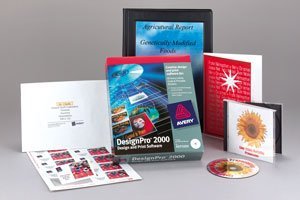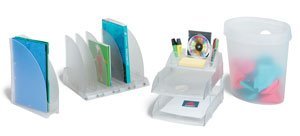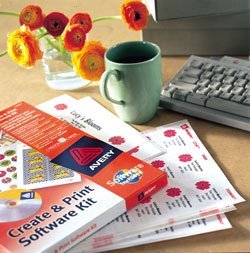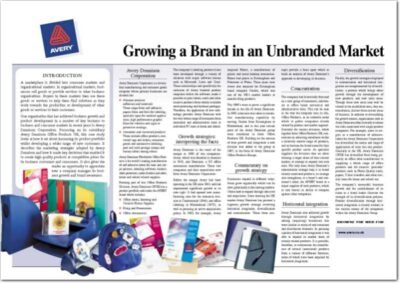
A marketplace is divided into consumer markets and organisational markets. In organisational markets, businesses sell goods or provide services to other business organisations. Buyers in these markets then use these goods or services to help them find solutions as they work towards the production or development of other goods or services for their customers. One organisation that has achieved business growth and product development in a number of key business to business and consumer markets in recent years is Avery Dennison Corporation.
Focussing on its subsidiary Avery Dennison Office Products UK, this case study looks at how it set about increasing its product portfolio whilst developing a wider range of new customers. It describes the marketing strategies adopted by Avery Dennison and how it made key decisions that enabled it to create high quality products at competitive prices for its business customers and consumers. It also gives the reader an opportunity to appreciate how a company manages its business growth and brand awareness.
Avery Dennison Corporation is a diversified manufacturing and consumer goods company whose primary businesses are divided into:
- Pressure sensitive adhesives and materials – These range from self-adhesive paper films and foils for labelling, speciality tapes for medical applications, high performance graphic films for vehicles and signs to protective coatings.
- Consumer and converted products – These include office products, converted tags and tickets, consumer goods and automotive labelling, peel and stick postage stamps and battery labels among others.
Avery Dennison Worldwide Office Products is the world’s leading manufacturer of self-adhesive labels for laser and inkjet printers, labelling software, binders, sheet protectors, index dividers and other, home and school related supplies. Forming part of this Office Products Division, Avery Dennison OPUK has a product portfolio sold under the AVERY brand which includes:
- office labels
- indexing and creative printer supplies
- filing and presentation
- office accessories.
The company’s labelling products have been developed through a variety of alliances with major software houses such as Microsoft, Lotus and Corel. These relationships and specifically the inclusion of Avery branded product templates within the software, make it possible to print labels, cards and other creative products from widely available word processing and database packages. Therefore, the application of new technology provides Avery Dennison with the very widest range of consumers from secretarial and administrative users to individual PC users at home and school.
Growth strategies: interpreting the facts

Avery Dennison is the result of the merger in 1990 of two companies: Avery, which was founded in America in 1935, and Dennison, a US office accessories manufacturer. These two companies and their acquisitions now form Avery Dennison Corporation.
Before the merger, Avery had been operating in the UK since 1963 and had experienced significant growth in its own right. It had opened new manufacturing sites for the industrial division in Cumbernauld (1964), and office labelling in Maidenhead (1975), as well as pursuing an active acquisitions policy. In 1985, for example, Avery acquired Myers, a manufacturer of plastic and metal desktop accessories. Myers had plants in Birmingham and Newtown in Wales. Three years later Avery also acquired the Birmingham based company Guidex, which was one of the UK’s market leaders in manilla filing products.
The 1990s were to prove a significant decade in the life of Avery Dennison. In 1992 a decision was taken to streamline manufacturing capability by moving Guidex from Birmingham to Maidenhead, and in this year certain parts of the Avery Dennison Group were combined to form Office Products UK. Building on the success of their growth and integration a new division was added to the group in 1997, in the form of Avery Dennison Office Products Europe.
Growth strategies
Businesses expand in different ways. Some grow organically which can be slow, particularly in fast-moving markets. Others look to expand through take-over and acquisition.
Since entering the UK market Avery Dennison has pursued a vigorous growth strategy involving horizontal integration, diversification and concentration. These three concepts provide a basis upon which to build an analysis of Avery Dennison’s approach to developing its business.
Different approaches to growth
Concentration

The company had historically focussed on a core group of consumers, individuals in office based secretarial and administrative roles. This can be seen in the way the company uses its title, Office Products, as an umbrella under which to gather companies closely related by product and market segment. Similarly, the various divisions, which together form Office Products UK, concentrate on achieving excellence within a relatively narrow range of products, and so become the brand name for their specific product sector.
As specialist suppliers, the divisions then set about winning a larger share of their current market, or attempting to expand into new ones. Not only does Avery Dennison’s concentration strategy help it to brand closely associated products, its strategy also strengthens, in a buyer’s and consumer’s mind, the Avery brand as a major supplier of such products, which in turn boosts its ability to compete against other companies.
Horizontal integration
Avery Dennison also achieved growth through horizontal integration by adding (acquiring) businesses that were similar in terms of the end consumer and distribution channels. In pursuing a policy of horizontal integration it was able to expand its market share of closely related products. It is possible, therefore, to concentrate on the manufacture of several (associated) products from a variety of different factories, some of which have been acquired by horizontal integration.
Diversification

Finally, the growth strategies displayed in concentration and horizontal integration are complemented by diversification: a process which brings about growth through the development of new products and new sales areas. Though these new areas may well be related to the established ones, they are, nonetheless, distinct from current areas of business.
In addition to diversifying for growth reasons, organisations such as Avery Dennison often diversify to reduce the risks associated with single product companies. For example, since its origins as a manufacturer of adhesive labels the Avery Dennison Corporation has diversified the nature and range of applications of even this one product.
Similarly in the UK, Avery Dennison OPUK has diversified from being primarily an office label manufacturer to supplying a whole range of office products and A4 creative ‘printable’ products such as Photo-Quality cards, papers, T-shirt transfers and other novelty items for home and school use. The company’s successful business growth and the establishment of its name as a brand leader illustrate the strength of its diversification policies. Product diversification through horizontal integration is clearly evident in the various names of the companies within the Avery Dennison Group.
Further evidence of Avery Dennison’s energetic approach to diversification can be seen in the evolution of one of its primary products: the adhesive label mentioned above. Patented in 1935 by R Stanton Avery, its inventor, the self-adhesive labelling process now has many varied and speciality uses. Information technology and software have added a new range of labelling applications and, in turn, increased the depth of Avery Dennison’s customer base.
To complete a description of its diversification, it is worth contrasting Avery Dennison’s concentric diversification with that of conglomerate diversification. Conglomerate diversification takes place when an organisation diversifies into areas which are unrelated to its current business.
Unlike Avery Dennison, conglomerates are parent companies which own businesses that manufacture products which are so different from each other it is difficult for them to share skills and technologies. With the exception of finance, it is difficult for individual companies within a conglomerate to offer each other mutual support. Avery Dennison’s concentric diversification, on the other hand, took place through related products and markets and, therefore, contrasts markedly with the growth strategies of conglomerates. Avery Dennison has, it would seem, avoided any strategy which works against concentration and horizontal integration.
Marketing

Marketing involves understanding customers and meeting their needs. This has long been a major concern of Avery Dennison as the means to achieve business growth. Indeed, strategies of concentration, horizontal integration and diversification have all served to improve Avery Dennison’s capacity to meet its customers’ needs. An example of this is to be found in product diversification which now reaches into retail outlets and home use with the increasing penetration and use of PCs.
In the wider marketplace of advertising, packaging, design, barcoding and branding, the other divisions have managed to satisfy demanding, technology-led needs – in part by creating developmental alliances with companies in new technology and customers with specific application needs.
The application of new technologies in turn creates new customer needs. The PC revolution of the late 1980s in the office and more recently in the home led to a demand for labels that could be printed reliably in personal laser and inkjet printers. This presented quite a technical problem, given the temperature and the tortuous pathway paper must take on its way through a laser printer. The ability to produce the right kind of ‘laser labels’ while ensuring that templates were included within the most popular software, offered Avery Dennison the opportunity for a branded product, capable of winning the market for laser printing against inferior, non-compatible competition.
Adding value

Whilst branding within the office products market is common, few brands offer real value as distinct from merely achieving customer awareness. The problem, therefore, for Avery Dennison, as for any company, is how to add real value to a branded product.
The value in the case of Avery Dennison’s ‘laser labels’ is to be found in the software alliances, the quality of adhesive paper construction and the consumer promise offered. Unique amongst its competition the ‘AVERY laser label’ is advertised as ‘jam-free’ and accompanied by a satisfaction guarantee, while free helplines manned by dedicated Consumer Centre personnel offer ongoing advice and assistance.
Creating customer awareness and loyalty

The company uses a variety of means to raise customer awareness of the AVERY brand and its products. These include:
- Advertising – Sending messages through the media to inform or influence the people who receive them.
- Distribution – The process of making goods available for consumers.
- Consumer support -Providing a range of services both before and after sales have taken place to ensure that customers are happy with the products they have purchased.
- Consumer loyalty- Developing long-term relationships with customers.
- Trade support- Providing the help that distributors require to enter and develop markets.
- An active website – Providing information and enablement through free software downloads.
Another means by which to create brand awareness is through Alliances, which include templates within software products. For example, opening Microsoft Word and looking under tools, envelopes and labels, will reveal the company’s product codes. This ensures that the AVERY brand is brought to the attention of PC users. Alliances and joint activities of this kind have been arranged with other related software producers.
Since 1995 Avery Dennison has run annual brand awareness campaigns. Typical media for these campaigns have included the following advertising exercises:
- on tube and escalator panels throughout London Underground
- on sides of buses in Birmingham, Manchester and Leeds
- in national and regional newspapers
- in the office and secretarial press.
Conclusion

Since its arrival as a manufacturing force within the UK economy, Avery Dennison has experienced rapid business growth and market awareness.
Its strategies for growth rely on the quality of its products and their range of applications. The company has effectively used new technologies and integrated them with product applications.
 Cause Marketing - Vodafone's partnership with The National Autistic Society (MP3)
Cause Marketing - Vodafone's partnership with The National Autistic Society (MP3)  Growing a brand in an unbranded market (PDF)
Growing a brand in an unbranded market (PDF) 